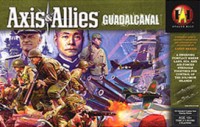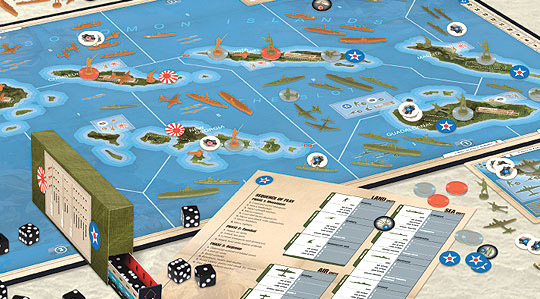
Axis & Allies Guadalcanal
2
13+
120+

A Sweeping Conflict Where Military Forces Struggle for Control of the Solomon Islands
August 1942: The Solomon Islands
Japan occupies the Solomon Islands, interfering with Allied supply lines in the South Pacific. In a surprise attack, the Americans capture Guadalcanal and its invaluable airstrip. As the Imperial Navy struggles to regain and strengthen its hold on the Solomons, the U.S. must press its counterattack in order to seize control of the island chain. Axis & Allies Guadalcanal challenges you to command a fleet of ships, direct aircraft, and deploy ground forces in order to dominate the enemy in one of the crucial campaigns of World War II.

images © Wizards of the Coast
User Reviews (2)
Add a Review for "Axis & Allies Guadalcanal"
You must be logged in to add a review.

Axis & Allies: Guadalcanal is an interesting beast. It looks and feels like Axis & Allies, but the mechanics and strategy are completely different, so seasoned A&A players may have to ignore their instincts to be successful here.
Playing the game
The objective of the game is simple enough: Earn 15 victory points before your opponent. VPs are earned by building and controlling airfields on the islands, as well as destroying your opponent’s capital ships. During most games a player will earn a minimum of two or three VPs per round, so most games will last around five rounds. Time spend will likely be around two hours once both players know their way around the game.
The biggest change from the base games is the attack system. Attacking is done with a battle box, a small box with twelve dice inside and a list of units in order from 1 to 12. Hits are assigned by the box itself, so it’s difficult to determine if the attack will pay off before you make your move. It also requires more consideration when moving units into harm’s way. For example, you move a few transports to a sea zone in anticipation of dropping off land units there to gain control of the island. Traditional A&A thinking would say to move other ships along with them, especially battleships, which in Guadalcanal can ignore the first hit they take each round without being damaged. However, with the battle box, you can’t choose your casualties, so whatever defense you send along with your transports could fail to protect them depending on the roll.
Also complicating things is the fact that attacks are done in waves: first against air units, then sea units, and finally on land units. So when considering how a land battle will go on an island, you need to consider what air and sea units may or may not survive their attack phases. This can lead to a bit of strategy paralysis for deep thinking players.
All that is not to say that it is a bad battle system. Despite a bit of randomness thrown in by the battlebox, I like the new system and the challenges it presents. Just be prepared for a bit of a learning curve for new players. This is one game where a person playing his 10th game will almost always destroy someone playing his 1st or 2nd.
Good things about the game
Every game of Guadalcanal I’ve played has been pretty different from the others. The decisions a player makes will need to take what his opponent is doing in to account for him to succeed. In some games I’ve aggressively pushed for new islands in the middle of the map, while in others I’ve played more defensively while reacting to my opponent. Each method has both worked well and worked poorly, so there is no “once you learn this strategy you’ll win every time” situation here.
Not as good things
The components are a mixed bag. The board itself and the plastic units are excellent, although it is a little hard to distinguish between the battleship and the cruiser on the U.S. side. The player reference cards are huge, but very useful.
I don’t really like the battle box. It’s fairly small and I don’t feel like the dice inside are getting a good randomizing roll. I ended up printing up this battle strip and buying the matching dice to go with it. This adds a little time to each roll to get the dice straight, but it’s a good solution.
I also don’t like how recent A&A games don’t include paper money for players to work with. In Guadalcanal, each player has a pretty significant amount of money to spend on each round, and for me, keeping track of what I’m getting without some kind of physical money is really difficult. I ended up stealing the amount of money the game needs from my 1940 games (and no, they didn’t come with money either – I bought their money on the internet).
Important side note
Be sure you look up the FAQ online. The manual contains a huge error, stating that each player gets 5 IPC plus 2 IPC per island they control. Actually, each player gets 10 IPC plus 4 IPC per island. They say the game is playable either way, but it wouldn’t be near as interesting with half the money to spend each round.
Conclusion
Overall, I really enjoy Guadalcanal, and I think it’s my favorite of the offshoot A&A games (this, Battle of the Bulge, and D-Day). The strategy is deep enough to make it a different experience every time. There is a lot of decision making involved, as well as trying to predict what decisions your opponent is about to make. You have to think a few steps ahead to be successful. And there is a lot of tension as it plays out to keep it interesting. I highly recommend it if you’re looking for a two player wargame with a little bit deeper strategy element than standard A&A.
this is probably the best one if you gonna buy one outside of the world map , pacific, or just europe… this is the best one imo